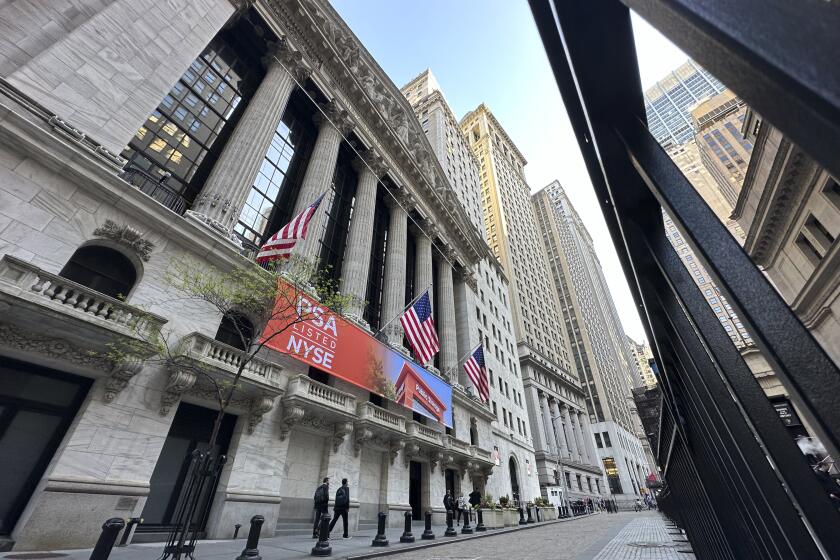Boom or thud?
FROM his home in the Adams Hill neighborhood, Richard Horgan has a sweeping view of downtown Glendale framed by the Verdugo Mountains. It’s a lovely panorama -- one that’s about to change.
In the coming months, a $264-million mega-development featuring high-end shops and restaurants, a 16-screen theater complex, upscale residential units and a park will begin to take shape on a 15.5-acre patch of downtown, transforming Horgan’s view as it redefines central Glendale. At the helm of the project is developer Rick Caruso, whose signature complex, the Grove, redefined the Farmers Market area.
Before it received the green light in December, Glendale residents had debated the Americana at Brand for more than two years. On one side are those worried about increased traffic and rising rents, upset that the city agreed to pay an estimated $77 million in land and improvement costs. On the other are folks thrilled by the prospect of new places to hang out and spend their cash, hopeful the venture will give local home values a bump when it opens late next year.
With a new big development always just around the corner in Southern California, the controversy over the Americana raises the question: Do such projects improve the quality of life for residents? The answer lies somewhere between the Grove and the Americana, two cases in point by the same developer.
Horgan, 42, a married entertainment journalist with a 6-year-old son, is among those who believe Glendale -- despite its nearly 200,000 residents and relative affluence -- currently lacks the retail, dining and cultural amenities to be an appealing draw, even for local residents.
“Ultimately, I think it will be good for Glendale. Look at what the Grove has done for the Farmers Market area. It’s hotter than ever before,” said Horgan, referring to Caruso’s large retail and restaurant complex that opened three years ago in L.A.’s Fairfax district. “I definitely think that three months after the Americana opens, a lot of [Glendale homeowners] will be able to throw $10,000 to $20,000 onto the asking price of their house, and they’d probably get it.”
But trying to predict how a home’s proximity to a commercial development affects its value is the stuff of soothsayers. As elsewhere, the prices in Glendale have been on a rapid upward march over the last few years and they may not be able to go much higher even with the arrival of the Americana.
The Horgans, who bought their four-bedroom, 1,800-square-foot home for about $400,000 three years ago, recently had it appraised at more than $670,000 for a refi. But Horgan has noticed that houses for sale in his neighborhood are lingering on the market longer than they did a few months ago.
“If the market stagnates,” he said, the Americana “just might perk the area back up.”
There are signs that the Grove had an impact on surrounding residential properties. Many home sale and rental listings in the area use the Grove as a marketing hook. To borrow a phrase favored by the developer, “It’s become part of the neighborhood’s vernacular.”
The Americana has been a much-discussed topic among Glendale real estate agents and it too is already making its way into sales pitches, said Coldwell Banker’s Hattie Ramirez.
“Anything that improves the quality of life is going to have a positive impact on real estate,” said Ramirez, who sells real estate in the area. “When you’ve got a higher-end retail district it can boost the city’s image and boost home values.”
There is also statistical evidence that suggests the Grove has helped increase home values. Between January 2002, when the Grove opened, and November 2005, the total price-per-square-foot appreciation in the two ZIP Codes closest to the Grove (90036 and 90028) outpaced the Los Angeles County average by 26%, according to DataQuick Information Systems. What those numbers don’t indicate is whether homes closest to the project -- those most likely to deal with higher traffic and other pitfalls -- are gaining in value at the same rate as ones farther away.
DataQuick analyst John Karevoll said it’s not a given that home values will rise simply because a developer is throwing up a bunch of new stores and restaurants nearby. But, he said, it is often the case.
“If what they are building is higher end than what is already there, it will tug values up,” Karevoll said. “Look at the 210 [Freeway] corridor, from Claremont to Ontario. Clearly the retail projects that have gone up there have had a positive impact on home values.”
Karevoll also cited Santa Monica’s Third Street Promenade and downtown San Diego as areas where the emergence of high-end shopping and dining amenities has been felt on local property values.
As Caruso did with the Grove, he made an effort to win over the local real estate community to help sell his project to residents with presentations at City Hall, an aggressive public relations campaign and meetings held in people’s living rooms.
Gerri Cragnotti, owner of the boutique realty company G&C; Properties, has lived in Glendale for more than 30 years. She was among those who volunteered time to support the Americana ahead of a September 2004 vote that asked residents to decide on three zoning changes required for the Americana to be built. They all passed by a whisker, with none of the three receiving even 52% approval.
Not surprisingly, Cragnott believes Glendale almost missed out on a golden opportunity.
“A lot of people in Glendale have money to spend, and they usually spend it somewhere else,” Cragnotti said. “It helps the city to have residents spending their dollars here.”
That point is echoed by Jack Keyser, chief economist for the nonprofit Los Angeles Economic Development Corp.
“When you have a large retail center that is successful, it brings in a lot of tax revenue,” Keyser said. “And that’s what helps a city maintain a high level of public safety, nice parks and the other things that make it a desirable place to live.”
Among the reasons cited by many opposing the Americana were the lifestyle concerns that have become the bane of developers throughout the region. Traffic is among them. Set squarely in the center of downtown and bordering some of the city’s busiest intersections, some fear that the Americana could turn central Glendale into a virtual parking lot.
The differences of opinion over the Americana also exposed some class tensions in Glendale.
The project has received mixed support from residents in Glendale’s affluent northern hillside neighborhoods, but has been bitterly opposed by others, mostly renters, who live in the lower-lying areas near downtown and would bear the brunt of any excess traffic. Some also have argued that the development could push up the price of rents and drive out existing residents.
“There’s no question that this is going to cause more traffic and make the streets more congested,” said Albert Hofmann, a retired Jet Propulsion Laboratory engineer and past president of the Glendale Homeowners Coordinating Council.
Perhaps the most galvanizing issue for opponents has been the terms of the developer’s deal with the city. While it’s easy to be enthusiastic about new places to dine and a spiffy new movie theater, critics point out that it comes at a steep price.
The estimated $77 million Glendale is paying to acquire the land, which is being turned over to the developer, and install sidewalks, lighting, landscaping and other improvements, rubs longtime residents like Harry Zavos the wrong way. A professor at Loyola Law School in Los Angeles, he said he believes the city negotiated a bad deal, and that the money could be better spent in other areas, such as street improvements, which would benefit residents equally.
“It’s not like we are getting a project for free,” Caruso said. “We’re investing $264 million.”
Unlike the Grove and Caruso’s other projects in Calabasas and Thousand Oaks, the Americana will include 100 condominiums and 238 apartment units with amenities such as an on-site gym and concierge service. Despite the city’s contribution of the land, none of the units are being built as affordable housing, which also rankles some critics of the project.
As for the split vote, Caruso and city officials said it wouldn’t have been nearly so close if not for a bitter campaign launched by General Growth Properties, the owner of the Glendale Galleria, which sits literally across the street from where the Americana will be built.
“They hyped the traffic issue, they hyped the congestion issue,” said Glendale city manager Jim Starbird.
General Growth poured more than $1 million into trying to defeat the zoning propositions and played a leading role in organizing many disparate interests to rally against it. But Zavos said that many residents voted against the project on its merits.
“The city bears all the risks,” he said, but stands to get “none of the profits.”
Starbird, however, said the city is trying to focus on the long-term picture. “As goes downtown so goes the image of the community,” he said. “People want to live in a place where there is a sense of vitality.”
Horgan can relate to that. Although they’ve only lived in Glendale a few years, the Horgans have contemplated moving. But Horgan says the project has helped change his thinking. He’s curious about the new mix of downtown shops and restaurants, and doesn’t want to make the mistake of selling too soon.
“We’re going to hang around,” he said. “We want to see what kind of impact it is going to have on Glendale.”
*
Darrell Satzman can be reached at satzman@earthlink.net.






